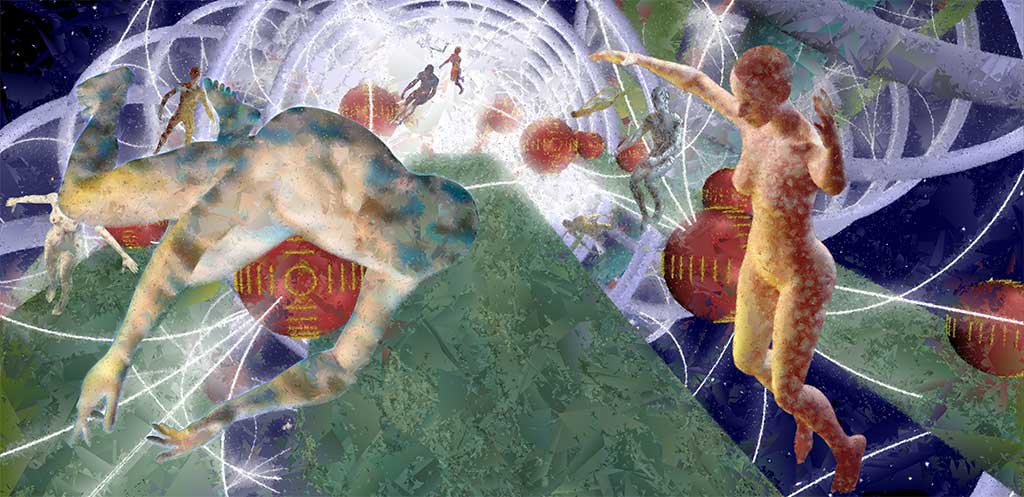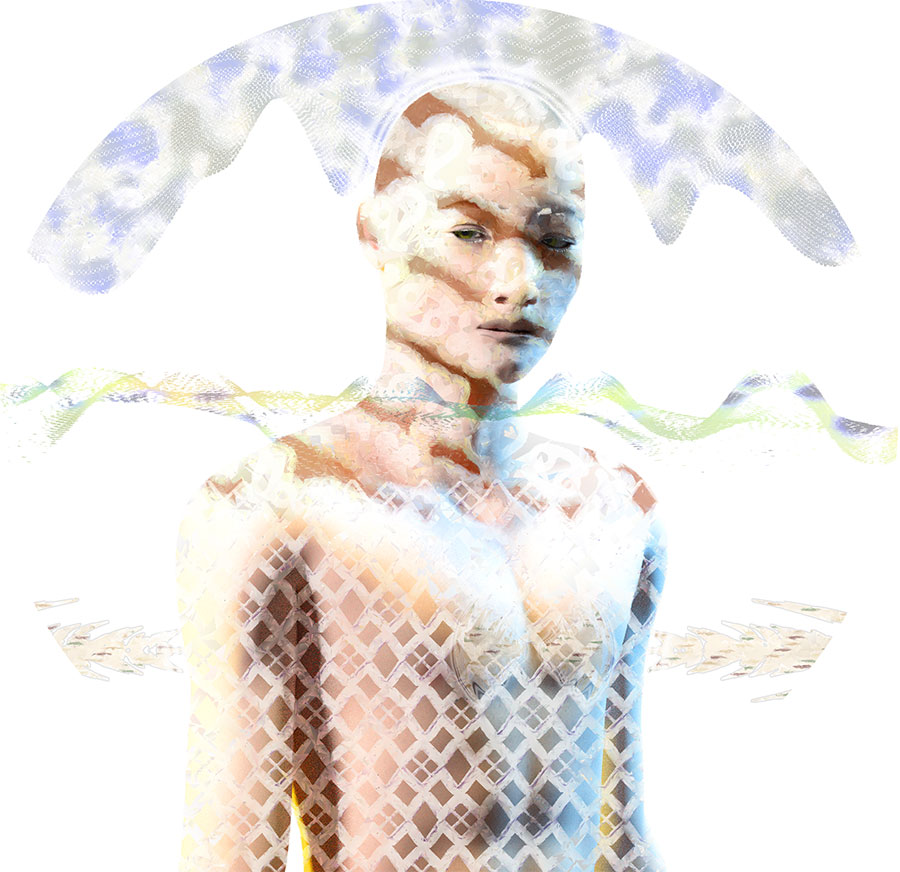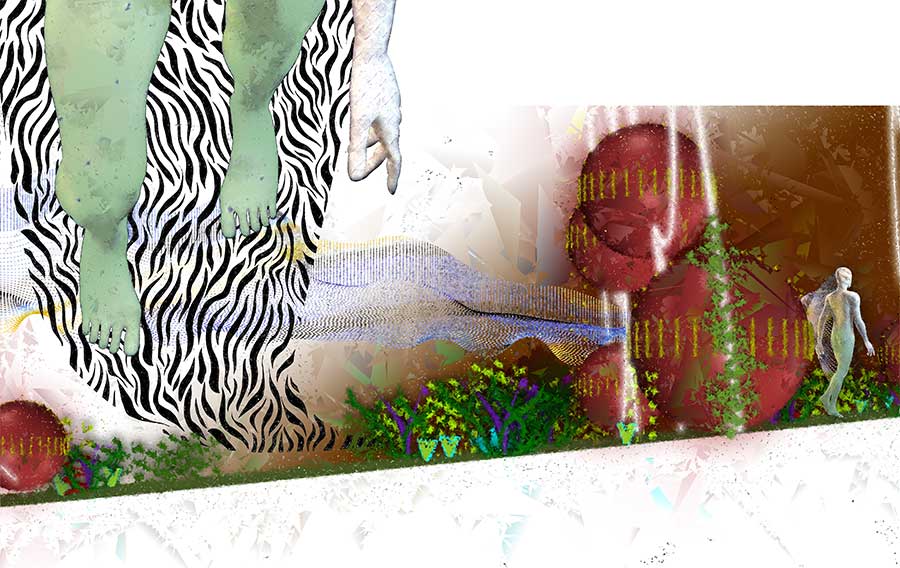Inspiring talk with multimedia artist and visionary Trenlin Hubbert
American artist Trenlin Hubbert presents us her extraordinary eclectic works and her ambition to enhance people creativity and innovative thinking.
Interview by:
Isabella Biava
Artworks by:
Trenlin Hubbert
An eclectic artist, always ready for adventures and eager to discover whatever is unknown, Trenlin Hubbert calls herself a multimedia storyteller who loves to express herself through different ways, painting, sculpture, graphic design, installation, writings…
Growing up in an artistic environment, Trenlin started to paint when she was four, but her curiosity and questioning mind brought her to explore other fields, graduating in architecture, and then climbing the corporate ladders of prestigious companies in the booming America of the 80s.
There she would rediscover her love for art in its multiple forms and so decided to let her authentic self be the guide, going back onto her artistic journey.
Despite her high education she loves to be a self-learner and explore new territories as she did when she wrote her first science fiction book, The Mentor for which she won the library journal indie ebook award for best science fiction. She loves to combine different techniques and media, creating extraordinary original works with the ultimate goal to enhance people creativity and innovative thinking.
Originally from San Francisco, she fell in love with Santa Fe where she lived most of her creative life. She has now moved to San Cristobal de las Casas, in Chiapas, Mexico, until the next wanderlust calling. Here she shares with us her artistic journey and works.
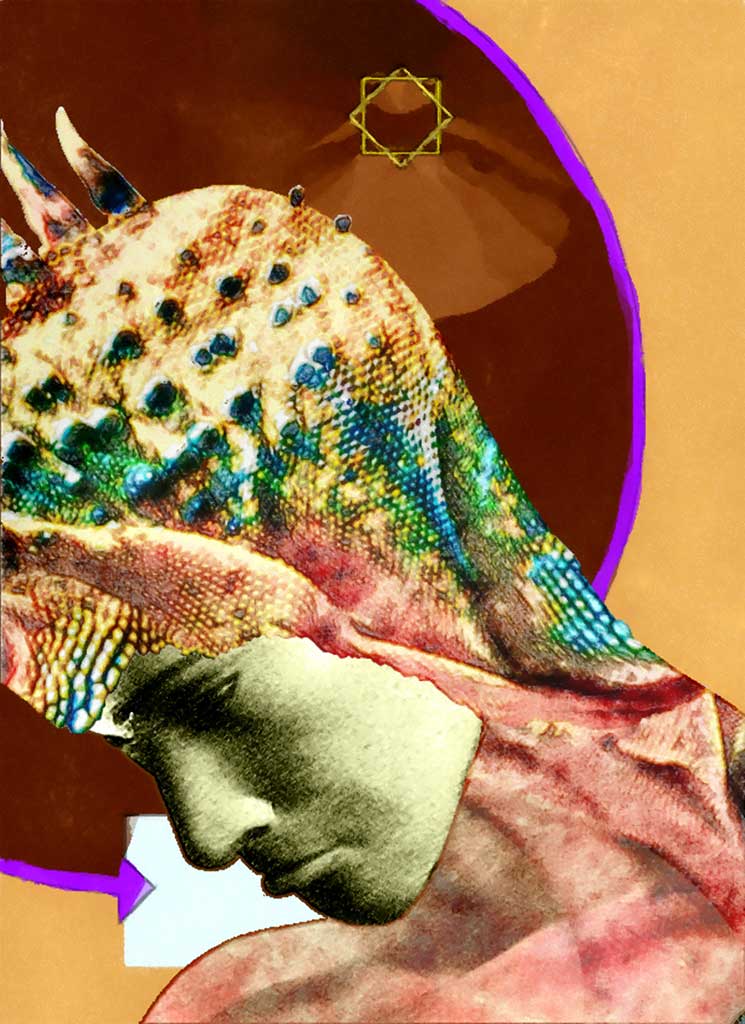
Isabella Biava - So you are an architect, an illustrator, a painter, a tech geek, a writer…
Which one do you prefer to be called? Or shall we say you are an eclectic artist?
Trenlin Hubbert - I would say am a multimedia artist, and certainly yes, I am eclectic.
I was an architect, way back and then I become an engineer by mistake.
IB - Oh I missed that one. Can you tell us more about it and all your background?
TH - Well, I didn’t mention it because it was just one more complication!
So, I came out of college, I got "the good job". And that was in the go go 80s. I was in Kalamazoo Michigan working for the company which I thought it was the best company, with the best projects, and I had the best job, and I was very successful.
And I hated it.
I felt like I was the house servant, the high paid slave, the slave with privileges.
And that was not what I was looking for.
I felt like I had found all that success and that was absolutely not what I would think of as success.
So, I quit the job and started to cross the country.
I was 28 and I was just trying to decide what to do with my life.
I came to New Mexico and I was camping and going to different places and just checking stuff out. I just fell in love with that land and so I stayed.
And in Santa Fe, back in those days, I realized they had no architecture per se. People built their own house and they were like blockhouses and most of the architecture was being done by engineers. That was really the only way in for me.
So, I got a job with an engineering company and bringing within my unique perspective which is the one of a designer and not a mathematician.
However, I was working for a corporation, I was an “engineer” and I felt like there was no way out. It was a terrible trap (laugh). Because I didn’t want to be an engineer. But those were the companies I would always go back to.
So I would take three years off to be a painter and three years on and I worked for the corporation and then off again…
IB - But you could have brought your knowledge in design and art into the engineering world.
TH - I had a good intellect for the technical which is why I think I write science fiction.
I could take their systems and completely change them around so they were pretty and beautiful. So, I was designing wastewater treatment systems that were parks. But still, I was working for the corporation and always working and getting paid a lot but not living the kind of balanced life that I wanted. So I would quit the job and back to painting and be terribly poor but really happy.
I was originally educated in the 80s and learned computer graphics, so I would do the computer graphics for my work and make beautiful graphics and then I would come home and paint, with paint on canvas, giant canvases, some of them are as big as 80 feet.
Now, for the first time, I am taking the painting, the “hand graphics”, and combine it with computer graphics. My new apartment has 2 screws in the wall, and I am like: “oh ok, that’s where my first paint will go”.
IB - So talking about it now what are your projects for the future?
TH - I started writing science fiction because I felt like now everyone on the planet, in 2012 in particular, was focused on the end of the world, and, you know what?
If it’s the end of the world, then we don’t have to focus on it, that will go ahead and happen.
But if we want to change it, then we have to start focusing on what the future will look like.
And I could see what the future would look like, I just don’t know how to get there from here so I thought: “I am just going to write a book that shows the future, so that you don’t have to tell how to get there, you don’t have to say “these are the steps”. But you can say “this is what we are going to aim for, this is what we wanna see”.
As a pragmatist, in the book, I wanted to make sure that it was not some idealized fantasy where everybody is happy with how it is. I wanted the characters to disagree, to not quite see it the same way. Because I think that it’s true.
There is no “one way”.
That’s why I write science fiction. It was hard. I hated it. It was so much harder than paint, I can’t even tell you.
IB - What was hard about it?
TH - The stories come flying into my mind. I’ve never had writers’ block, but trying to figure out how to express is hard. It‘s a new art to me and in any art that’s new, you are going to have to start as a beginner.
I am a good writer, technically. As an engineer, I could write technical manuals. I could make it really clear.
However, to express emotions, experiences and all this other stuff that you are making up no less, it’s challenging.
And I am stubborn too. I don’t want to read a writer’s workshop that shows you how to write.
I want to discover my own way. That’s what I have done and that’s the result of what you see in the first book. Shaman Machine The mentor.
And now in the book, I am working on currently, I am going back to my roots, to the graphics, and then the words support that work, but they have to have each other in order to work.
To me it’s a little bit more fun because I would go in and wrote the whole story just in rough form and then I kind of refine the first half of it and I am doing the graphics to go with it and I’ll continue in that bent and then when I get done, I’ll take all the text out of it and do it all over again to make sure the text, as a work of art stand on his own too. And then put them back together.
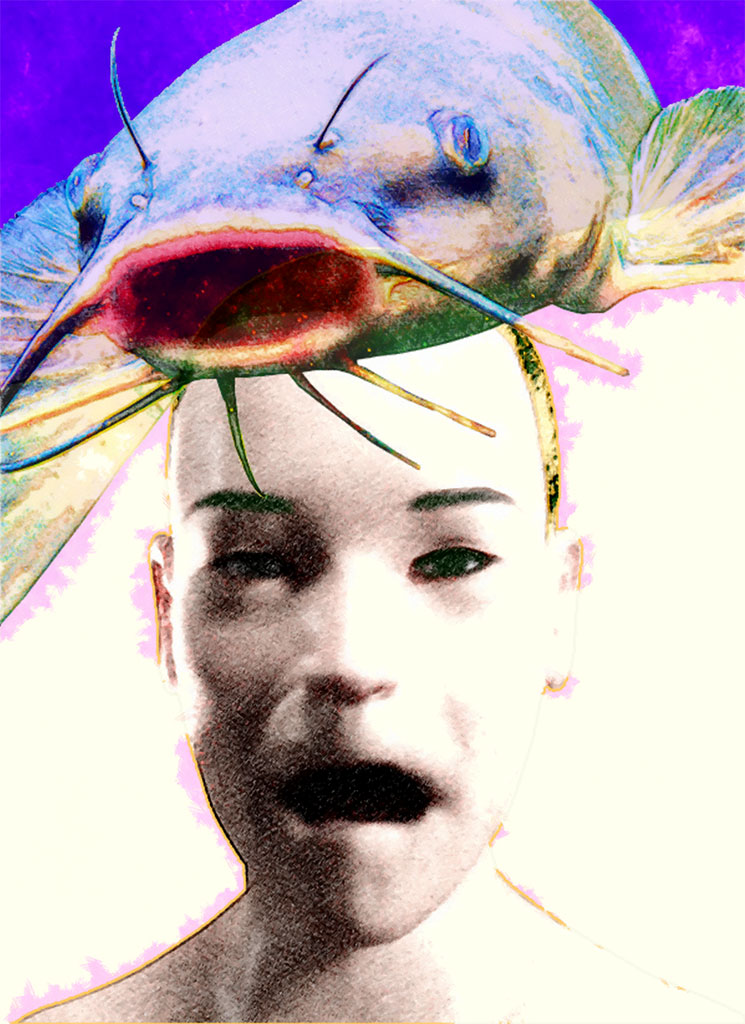
IB - So the text would be understandable without the graphic?
TH - They won’t be completely separated. Since I am not putting as much verbiage into the description of the environment, there has to be a kind of happy medium. Since it’s so fantastical.
The other book took place in two physical locations, the Earth, and Baru that are understandable because they are planets.
This book that I am writing takes place in space and underwater within a living spaceship. If I ever was going to illustrate something I thought this is a good one.
What I find is that most people have lost their ability to imagine something that they haven’t seen before. So, in the first book, I could be describing places and things that people had already heard of so it was easy to imagine. But in this book environments are less obvious, like for example living inside of a worm. Most people are going to have a hard time imagining that (laugh), right? So the graphics help a lot.
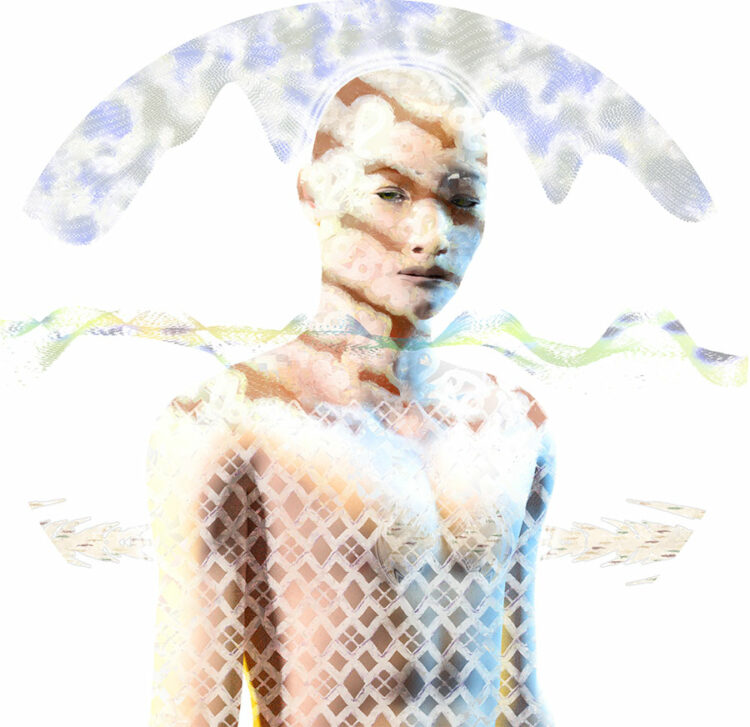
IB - In the first book one of your character Ziggy says something that I absolutely love and it is: “Art will save us”. Do you actually believe in it and in which way would art save us?
TH -Yes absolutely.
You see, Ziggy is an interesting character, he’s kind of crazy. And I like that, because then I can have him saying all of these truths and you don’t know which part is true and which part is crazy so I use him as my own voice, the same way that I use the robot.
I believe that we have cut out a part of our soul in order to become consumers.
We are supposed to buy things - I am talking about America, for my experience, I know this isn’t exactly the same everywhere else - all we are supposed to do is to become consumers. That’s our job and if we don’t consume we are “bad Americans”. Because “that‘s what keeps the economy going and we all fall on our knees for the economy, holy economy”! (laugh).
We had to take a part of our soul out in order to do that and I think the way we reclaim that part of our soul is to become creators again.
And that’s what an artist is, a creator, we are creating a unique life, unique “product”, we are creating different ways of interacting with each other. An artist is seen as the bad guy in the modern world because we analyze and question.
We don’t just take orders and do. And so, when a person begins to embrace himself as an artist they begin to move the world differently and that’s what we have to do. We have to begin to move through the world differently if we are going to change it.
We can’t just sit back here and save us from ourselves. It’s not going to happen, you know?
And so, whatever we create, all we need to become involved in that. I really believe that. You can’t have just most of the people vampiring off the artists. It’s not healthy for us, it’s not healthy for the planet and creates an imbalance that’s destructive.
IB - So do you think anyone who creates is an artist?
TH - Anyone who decides to re-embrace that part of their psyche is.
If you are willing to… because it makes you vulnerable to be an artist, too.
If you sit down and draw a picture now, will you be willing to show it to the world? Or sing a song in front of people? You would be nervous about that. It’s scary to bare yourself. That was the hardest part in writing the book. You can write this perfect little world where everybody’s good and nobody does anything wrong. Or, you can be honest, and that’s the hardest part.
And being honest with yourself first.
That’s the thing with art too.
When I paint, it would take me a month to finish one painting and then I would hang it on the wall and I would wake up in the morning and I would look at it and I would see something I had never seen before and I have spent the whole month working on it.
Because there is all that stuff leaking out that you are not aware that you are doing.
Somebody would come over and say wow I never saw that line in there before. And I’m like: “what line?” (laugh)
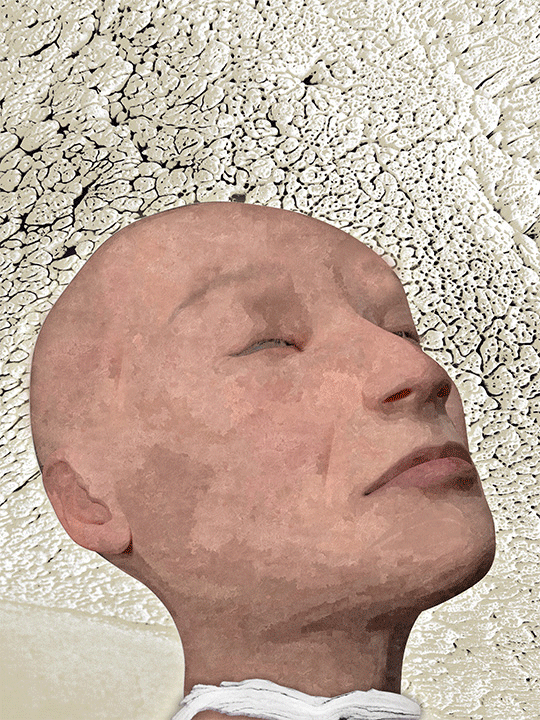
One of the Prayer's heads
IB - Is it what a painting should do? To create different perspectives?
TH - What I found is people always ask “What does it mean”? For some, it seems like a good question. But it never means one thing. It’s me expressing my view of the world or whatever it is that I am painting, MY view, and what I find beautiful is what YOU see when you look at that view. And so, when they come to me and I ask “what does it mean?” I always turn it around and I would say: “I don’t know, what do YOU see”? because that’s where it is interesting.
IB - Maybe a better question would be what are you trying to convey?
TH - I am not trying to convey. I am trying to evoke.
So I have no idea what’s that’s gonna do. I am always amazed at how people get so emotional about a piece of work.
IB - What’s your artistic process?
TH - My painting always involves models, but I cannot afford real models, so what I would do is to go to my favorite coffee shop and I would pick a stranger and ask him or her to take off their clothes and model for me. It’s easy for man and difficult to have women, who would be shyer. And the way I would sell them would be: “It would only take 10 minutes and then you will be forever part of my painting”.
And they would be like: “Ok, as long as you don’t paint this part or that part” (laugh)
So, I would bring them in and I would make myself busy doing something so as to make them comfortable to take off their clothes. And I would tell them in advance what the pose is going to be and show them.
Then, when they are ready, I would pull out my pen and I would go over and draw as fast as I can move, trying to get every important detail on certain things and take notes of what I knew would be important in the painting, like fingernails for example, and then I send them off.
I would transfer the drawing to a canvas and normally filling the entire canvas and then I would insert patterns and fill gaps with symbols and I would create a story. I have been always telling stories. I am always telling myself stories while I paint them.
I think of a story, I get the feeling of it and then I find the model and I ask them to hold a position according to the story. Like I did for the prayers’ series. I would tell the models to put themselves in a position of prayer. I wouldn’t tell them what it looks like so anyone would assume different positions.
So that’s a theme in my mind but I would make all these other discoveries in the process. Like for example, I would put an animal head in a person’s body and all these symbols.
To me, it is like a sort of channeling. I would channel the symbol. Like automatic writing. I would sit there and put the pencil in figure and I would put in all these symbols and I don’t know where they come from and then it’s set.
And then I would sit there and paint forever, in order to get the texture. Every line had to have at least 20 colors in it, otherwise, it’s not a good line and then the fields of just color, the texture has to be extremely complex, almost like pointillism, by the time I was done, dry brush on top of dry brush…
The choice of color would be red, yellow, blue. In order layer deep like that, I would go layer after layer changing the weight of each color every time. I would keep rotate, rotate, rotate as I found this is the best way to get these incredible scintillating colors. And then in the end when I am all done you will see orange, purple or blue… whatever you will see but it’s all there.
IB - How do you decide when the painting it’s finished
TH - When I am completely in love with it.
Because when you first start out, it’s ugly as hell.
When you put on that first coat and it’s literally purple orange and green, it’s ugly and boring, without texture. And then you keep adding, adding, adding.
As I mentioned I would be on the same painting all day every day for a month and I just keep going and it gets uglier and uglier and I just think: “Oh wow this is always going to be ugly. There is no saving… and then I would finally make it and it would be just beautiful and I wouldn’t stop looking at it. And I go: “Oh my God it’s so beautiful. I can’t touch anything, it’s perfect”.
IB - So when you begin you don’t have a final result in your mind?
TH - Oh no, I have no idea. It’s a journey. Like writing a book, I had no idea where I was going.
IB How has your relationship with art been changing over the years? You said you started when you were four and you were influenced by your mum who is a painter...
TH My mom was a painter and an all-around artist, really. She was a good professional mum. She studied art and home economics, so she was like a pro. (laugh)
She always had art supplies.
All that stuff was available. I had clay, pencils, paintings, all the good papers. We were 4 kids growing up together and all of us were playing with it.
I would particularly like oil paint and I always did that.
I went through a stage in high school I started doing political cartoons. I went through a stage where I built these giant frames, where you take a stencil and then push the paint through it, all different works where you use paint, only sometimes working with pen and ink.
I very occasionally worked with clay and then I went to art school in Texas and I was only 17.
And then my mom said: “Why don’t you learn something you don’t know?” And I was like: “That’s a freaking great idea!” And so I decided to go to architecture school and there I learned how to use all these other mediums, color pencils, markers, watercolors, just lots of stuff I wasn’t used to, until then.
The all-time I was in Michigan as an architect, I was working 80 hours a week, I had barely the time to sleep and I couldn’t work on my art and that’s where I thought that it was unsustainable, “I cannot work like this until I die”. That’s when I quit and ended up to Santa Fe. There I started painting again and I started the work with clay as in Santa Fe where you have a lot of clay in different colors. And that’s when I did the prayer’s heads, which I will think I will do again here.
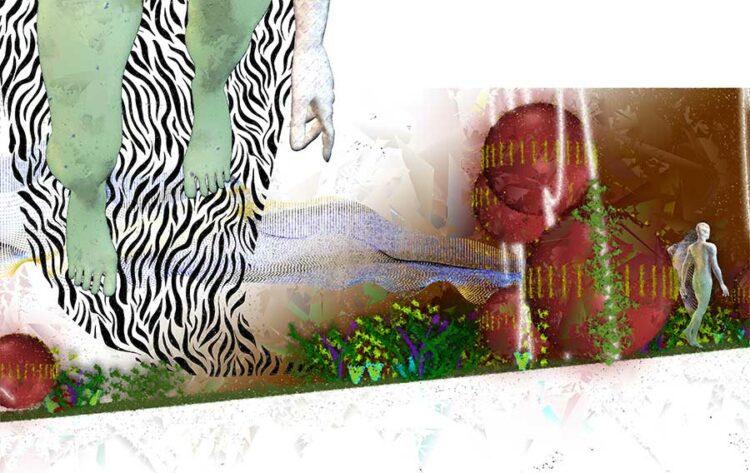
IB Tell me about the prayer’s heads.
I would sculpt these beautiful human heads just from shoulder blades up, looking up in a prayer position. I would not fire them, though. When they were finished, I would carve out the back of their head and make a landscape there, filling it up with rocks and crystals as we have so many there. And I would stick it out in an important place, like on top of a mountain and then it would rain, and, as they were not fired, it would all go away and what would be left was a pile of rocks. So, I put them out, put a prayer in it and let them go away. And people would tell me they were such a waste. I wouldn’t sell them and they would disappear like that. But to me it was just like a process. It was weight, a beautiful weight pile with rocks. I never sold them and a friend of mine wanted one, so I made one for her, but she put it in the house. And I told her that those were made to be left outside.
They are not supposed to be in the house and get dusty. She didn’t understand and so I decided I would never give them to anyone else as they don’t use them right.
But I decided to make another series of prayer’s heads here in San Cristobal and I am going to photograph the process of being disintegrated and take each of those images and add my paint so that the paint would be different in each one, and make a video, and create a show.
Plus inside the prayer’s head, I would put a shrine, so that when everything melts away, then it would be in it.
This is one of my projects I am thinking about.
I really enjoy putting different media together.
So I will take all these images and paint on them, and it would be another version of the novel.
IB How are you going to promote your work and what do you think about social media as a mean of promotions for artists?
I don’t really like social media. I use Facebook but everyone is actually my real friend. I have a public page but I never go there. I remember in 2010 was like a flood and all my friends are all on it and everybody was like collecting friends and back then there was no limitations and people would have up to 3000 friends. But I just can’t imagine even liking 3000 people. (laugh)
Then I have LinkedIn where I am more open and that’s where I have way more connections.
I am interested in this new “minds” social media site which is blockchain so nobody controls nor manipulate it and all open source so everybody can improve it.
What I decided to do in terms of promotion is first to have everything, all my works, interconnected.
So everything is referencing to each other and different parts are going towards different people.
In Santa Fe they have been talking about redesigning it for the future and they put out a call to everybody who is a science fiction writer or futurist artist to redesign the future Santa Fe for this magazine. So, they are calling all these people to contribute to different zine edition.
And since I had redesigned Santa Fe in my first book (again self-reference), I took out some passages and I am doing the graphics for that and I am going to submit that.
Since I am already known there, it will be easy.
What I find is that people who like my paintings also want to collect my books and my graphics. They want the whole collection. Like when I started to paint the quetzal (Guatemala money) or the dollar note and sell it for 10 USD. People would want them for their collection.
So, I found that being self-referential is a really good technique and I have connections in Santa Fe with galleries so the next show that I put together would probably be the illustrations from the books that I turn into paintings and I will bring the books as well to be bought.
IB Where one can see you from the other part of the world? There is nothing online besides the Saatchi art website.
TH I know, the only one I work with is Saatchi art. Here is where I will put all my paintings. It’s a great outlet with a good name, and people can buy them as well.
IB What would you suggest to young or not so young artists who want to start their career?
TH “Look how much energy you put into creating a life that you are not happy with!”
All that energy to meet deadlines, to show up to work, to a job you hate, all that energy to keep going.
All that energy to try and succeed and you don’t even want to do all that stuff.
Why not put all that energy into something you love, something you adore?
Instead of trying to focus on how to make it, put that energy into discovering what is your voice. And getting your voice out there. And I tell you what, people notice!
Everywhere I go people notice me and I didn’t even know why. I am just an old lady with white hair now. I used to be a cute little chick and I expected people to pay attention to me. But at this age, it doesn’t matter where I go everyone is interested in me and I find that very odd and the only reason I could find is because I am living very genuinely and people notice.
So, anybody that want to become an artist they need to start living genuinely. Start doing what you really want. Start focusing on what you are really passionate about, instead of putting all this energy into something you hate.
IB Beautiful. Thank you so much!
TH My pleasure!

